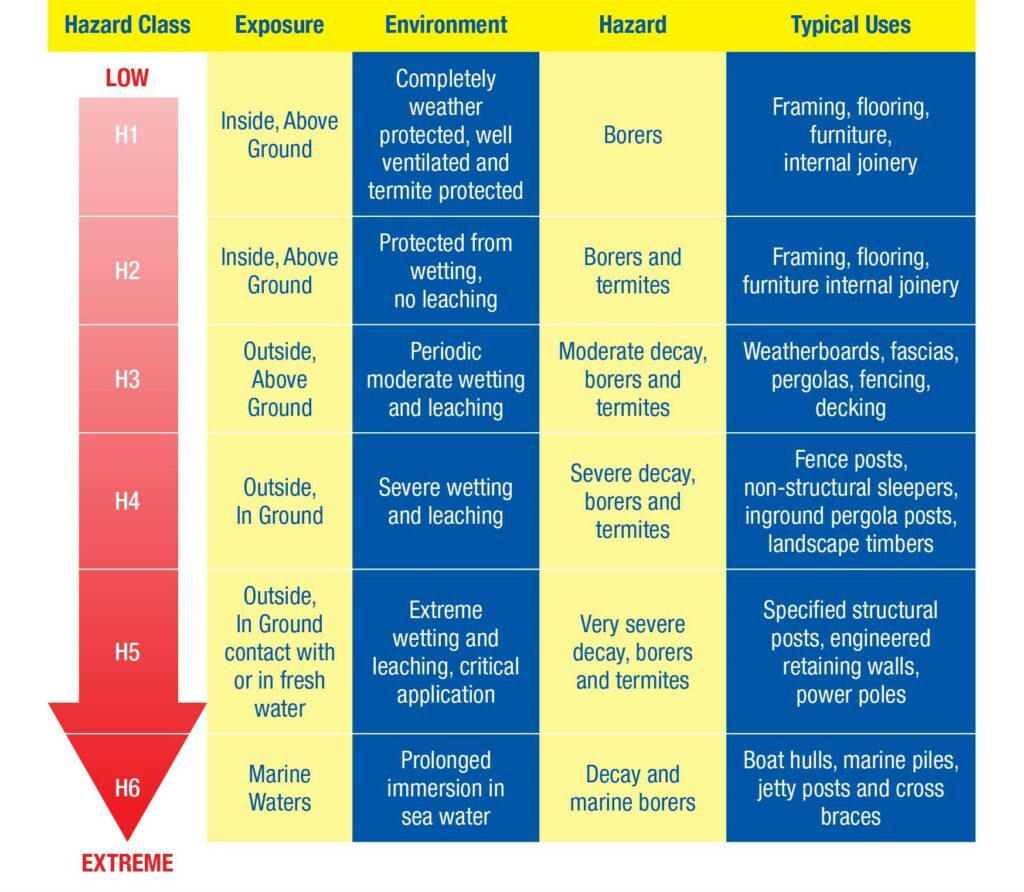Treated Pine Hazard Classes
Sep 13, 2021
Treated Pine Hazard Classes
While the native species of Australian hardwood like Red and Grey Ironbark, Forest Redgum, and Spotted Gum offer excellent natural durability with resistance to decay and insect attack, low durability timbers like Radiata Pine can be treated with modern preservative formulations to match the durability of Australian hardwood.
Sourced from sustainable plantation forests, Pine is a natural product that can go through a variety of treatments to increase its longevity. These treatments contain chemical solutions with fungicide and insecticide and are forced deep into the wood, thereby making it resistant to rotting and decaying. Treated Pine can be used for a wide range of applications like pergolas, decks, posts, and poles. Envelope treatments to Pine framing enable it to be termite resistant.
Timber Coatings and Hazard Levels
Although some treatments can improve pine surfaces, it does not protect it from weathering. A protective coating or penetrative oil applied on both treated pine and untreated hardwood can protect them from the long-term effects of weathering. It is important that all cut ends, joints, and bored holes have a preservative formulation applied.
There are specifications for the preservative treatments laid out in the AS/NZS 1604 parts 1-5. These standards specify the concentration of chemicals used to protect the timber from possible biological hazards and how deep it needs to penetrate to do the job. Once treated, the timber must be branded with the following information: plant number where the preservative treatment was carried out, preservative code number, and hazard class.
How to Determine Correct Level of Treatment Through Hazard classes?
It is the Hazard class that indicates if the product is ‘fit for purpose’ it is exposed to, and the level of protective treatment needed for the job at hand. Hazard classes have six main levels ranging from H1 to H6. There are also a number of sub-levels such as H2F which are used to ‘envelope treat’ Radiata Pine Framing against borers and termites south of the tropic. The table below will help you determine the level of treatment needed for different applications.

The uniform penetration of preservatives is not always easily achieved with Radiata Pine. This often happens when the wood to be treated contains both Sapwood and Heartwood (Truewood) that have different permeability. While Sapwood is highly absorbent and fully receives the preservative solutions under pressure, the Heartwood is more difficult to penetrate.
Treated Pine Sleepers are an example of this. However, there are many products available in Treated Pine and there are always new treatments being developed. Our Treated Pine decking has a Micronized Copper Preservative treatment, and our structural Treated Pine beams are treated with a Light Organic Solvent Preservative (LOSP) for easy penetration. Both these treatments achieve an H3 Hazard Level.
If you have more questions about treated pine and its installation, get in touch with Bowens Customer Service team at [email protected].
A loyalty account that gets you 5% off every shop
Ready to sign up?
Already have an account?
Login hereCustom pricing, 30-day trade credit + more
Ready to apply?
Already have an account?
Login here